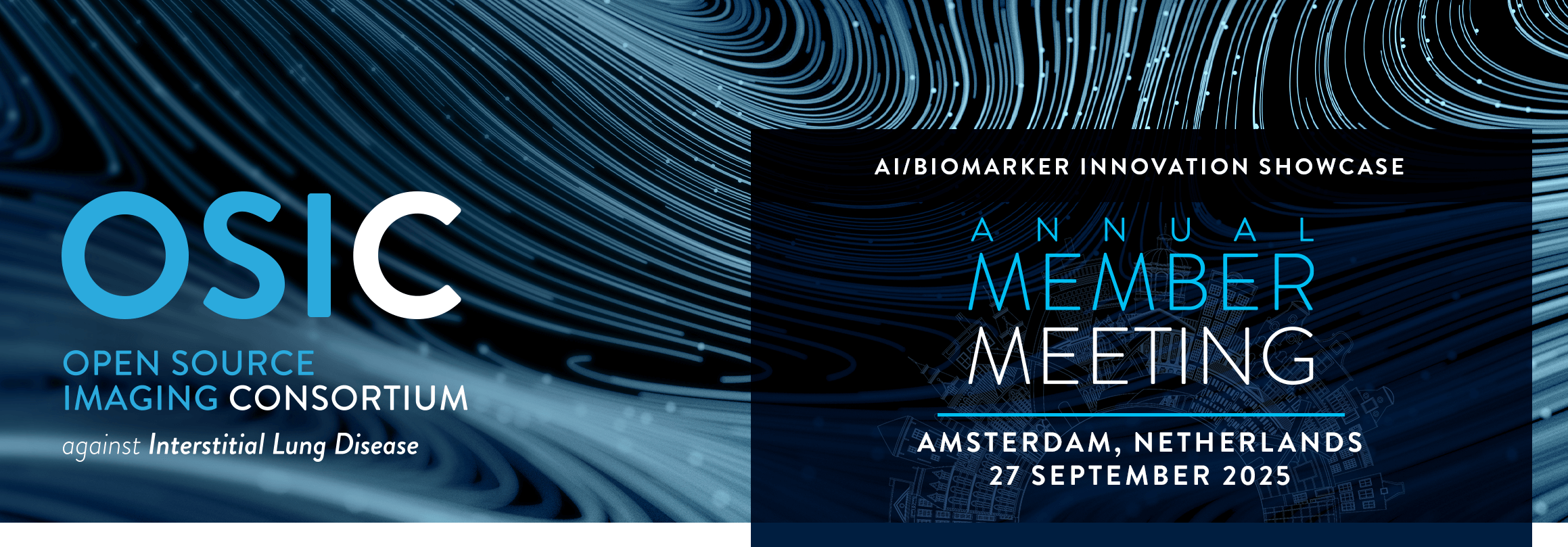
New Frontiers for Progress: Catalyzing Breakthroughs
Thank you to everyone who joined us in Amsterdam on Saturday, 27 September 2025 for our 4th annual OSIC Member Meeting & AI/Biomarker Innovation Showcase.
This year’s meeting was chaired by Dr. Kevin Brown, National Jewish Health, and was a day filled with bold ideas, breakthrough thinking, insightful presentations and collaborative discussions – all focused on shaping the future of lung disease research.
The agenda highlighted key opportunities for progress — from bronchiectasis as a promising new therapeutic frontier to advancing sarcoidosis understanding through global registries and AI. Attendees learned about innovative imaging techniques like Optical Coherence Tomography (OCT) and gained insights from world-leading experts in generative AI, predictive modeling, and interpretability. The event closed with inspiring success stories from OSIC members who are turning data into discovery.
Agenda
-
Saturday 27 September 2025
11:45 a.m. – 4:00 p.m.
11:45 – 16:00 (CEST)
-
Lunch Buffet
5th Floor Restaurant
11:45 a.m. – 12:15 p.m.
-
Member Meeting
6th Floor
12:30 p.m. – 4:00 p.m.
12:30 – 16:00 (CEST)
Bronchiectasis: A New Therapeutic Frontier
From Orphan Finding to Frontline Target
- Panelists
- Discussion Points
- Rising Global Prevalence & Burden: Why bronchiectasis is increasingly being recognized as a significant public health issue because of unmet need and the decline in quality of life
- Phenotyping & Endotyping Advances: Connecting imaging features with clinical subgroups to enable precision medicine approaches
- Overlap with Other Diseases: When bronchiectasis coexists with COPD, asthma, ILD, or post-infectious fibrosis
- AI & Quantification Opportunities: Automating airway measurements, mucus plugging scoring, and progression tracking
- Collaboration Call-to-Action: How OSIC members (pharma, machine learners, clinicians) can build a shared bronchiectasis resource
Sarcoidosis: From Complexity to Clarity?
- Discussion Points
- The Challenge: Sarcoidosis is complex, heterogeneous, and historically understudied.
- FSR’s Leadership: U.S. patient registry and partnership with OSIC; international registry planned for the future
- AI/ML Opportunities: Predicting progression, phenotyping multi-organ involvement, identifying novel biomarkers
- Engagement Opportunity: Inviting pharma and researchers to collaborate on future sarcoid AI initiatives
Beyond CT: How Optical Coherence Tomography Unlocks Microstructural Insight into Fibrosis
- Discussion Points
- Visualize healthy and diseased airway and lung microstructure in vivo over large volumes (as a form of vivo microscopy)
- Diagnose early lung disease at a microscopic level without needing invasive surgical biopsies
- Quantitatively measure changes over disease progression and therapy on a microscopic level
- Provide rich, quantitative data that could feed AI models for disease phenotyping and outcome prediction
- Can be used to diagnose and characterize many lung diseases, including fibrotic ILDs, COPD, small airways disease, bronchiectasis, and post-COVID fibrosis
Showcase Presentation: Generative AI in Action
- Presenter
- Discussion Points
- Predictive power: Could interpretable survival models predict disease progression and patient outcomes than traditional methods?
- Interpretability at the core: Attention maps that show which lung regions drive predictions, helping clinicians trust results
- Cross-disease potential: Can be applied across fibrotic ILDs, bronchiectasis, and post-COVID fibrosis to build a multi-disease model
Unlocking Innovation: Exploring New Features and Advanced Filters in the OSIC Cloud
- Discussion Points
- Overview of the latest enhancements to the OSIC Cloud platform, and how these features streamline data access and accelerate research workflows
- Demonstration of how new imaging filters and views, including tMPR and subpleural views, improve data visualization and analysis
- Exploration of the new collaboration tool designed for private cohort development
- Presentation of the live analytics dashboard for real-time insights
Turning Data Into Discovery:
The Achievements of OSIC Members with the OSIC Cloud’s Powerful Data
From core lab to clinic: improving patient care with AI imaging biomarkers
- Discussion Points
- Validation of algorithm performance and generalisability
- Demonstration of value and maximising impact
- Patient impact through clinical development and clinical adoption
When virtual OSIC database becomes virtuOSIC
- Discussion Points
- The OSIC database was instrumental in developing an estimated FVC (eFVC) metric that can be calculated from chest HRCT scans.
- eFVC mimics real FVC measurements, demonstrating a high correlation validated in the separate cohort.
- eFVC shows promise as a tool for monitoring disease status, predicting progression, and assessing response to pharmaceutical treatments.
AI-Based Quantification of Airway Diseases: From Comprehensive Characterization to Phenotyping and Progression Tracking
- Discussion Points
- How can AI-based quantification of airway wall thickening, mucus plugging, and bronchiectasis provide meaningful patient phenotypes?
- Could longitudinal tracking of AI-based airway quantification provide more precise disease trajectory assessment?
- What value does this bring to patient stratification and measuring treatment response?










